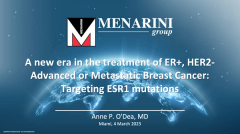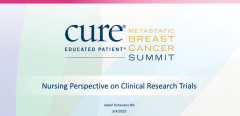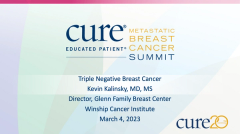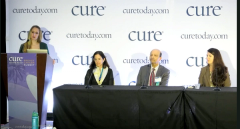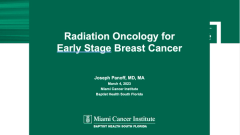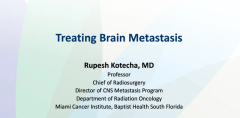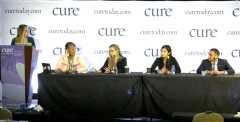
Educated Patient® Breast Cancer Summit at MBCC Precision Medicine Panel: March 4, 2023
Watch Dr. Susan Domchek, Dr. Debu Tripathy and Dr. Jennifer Gass answer questions about precision medicine during the CURE Educated Patient® Breast Cancer Summit at MBCC.
Episodes in this series

This panel was moderated by Kristie L. Kahl, and included Dr. Susan Domchek, executive director of the Basser Center for BRCA and director of the MacDonald Cancer Risk Evaluation Center at the University of Pennsylvania School of Medicine; CURE® editor in chief Dr. Debu Tripathy, chair of the Department of Breast Medical Oncology at The University of Texas MD Anderson Cancer Center; and Dr. Jennifer Gass, associate director of the genetics laboratory at Florida Cancer Specialists.
Kahl: Dr. Tripathy, how does circulating tumor DNA testing differ from tumor marker lab tests that are normally run?
Tripathy: So many of the tumor marker tests that we do involve looking at the protein, things like estrogen receptor, progesterone receptor and HER2 and that requires tissue. So that's commonly done when someone is newly diagnosed with breast cancer and they have a biopsy, or sometimes in patients who develop a new metastasis, we want to verify that it is a metastasis of cancer. We'll do a biopsy of the metastases. But at the same time, we will recheck the estrogen, progesterone and HER2 receptors because sometimes that shifts to DNA, or genomics as people call it. It is looking at the DNA sequence.
And sometimes it tells us the same thing that the protein does, but it can also look a little bit deeper. It can look at mutations and some of the proteins that drive cancer growth. And that is also done with either a tumor biopsy, but it can be done also with circulating tumor DNA with liquid biopsies. So they're looking basically at slightly different aspects of the cancer biology for both treatment decision making, which is really the most important, but also for research.
So tumor markers are proteins that can correlate with the amount of tumors someone has, especially for metastatic breast cancer. They're not perfect, because these are proteins that are made by normal cells, things like CA15, 3CA2729, CEA, those are normal proteins. But in cancer cells, the growth of the cancer is disorganized. So some of the proteins make it into the bloodstream. And that's what we're measuring with the serum markers. They're not recommended to be used in early-stage breast cancer, because they're not very accurate in terms of recurrence. So we're not using them, but it's possible in the future that they will be more accurate or that we will develop gene based (testing). But in metastatic cancer, some doctors use them, not at all, to help guide whether or not patients are responding to treatment. But it's important that the scans are still our gold standard to know if someone's responding. So these are sort of ancillary tests that might help us decide how frequently we may want to scan someone.
Audience: Dr. Domcheck, you mentioned that in the CARRIERS study in non-Hispanic White (patients). Is that Latinos who are not included, and you can report something whether or not it is applicable to women that were Latinas?
Domchek: In that specific analysis, we looked at self-identified Black women, compared to non-Hispanic White women. There was not a large percentage of women who were Hispanic who were self-identified Hispanic. We didn't see any major differences in terms of those numbers.
In terms of the numbers that I presented. It's just the numbers were small. And this is a major issue in genetics research that is catching up, by the way, which is we need to represent all races and ethnicities. And the good news is, though, that there had been, if you will, a lot of chatter, that there was a lot of differences between, if you will, Black women and White women, and we didn't see it. And it's the largest study to show that on a population basis. And again, although I didn't show the data, Asian women potentially have slightly lower risks of pathogenic variants and Latino women, it's pretty much the same, but more work is to be done.
And it's a good point. And I think it's also important that, as I mentioned, we're not done yet. What we've done so far is identify these genes. We have done things like whole exome sequencing, meaning in high-risk families. We've sequenced all the genes. So now we have to look more carefully at different ways that there can be gene changes. When we do say whole exome sequencing, we just sequence the genes but a lot of our DNA is actually not really an identified gene. It's other stuff. But changes in that other stuff can impact how genes function. And that's just an entirely new area that we're really just getting into now.
Kahl: We had a question come in from the virtual audience, the patient's on the PATHFINDER 2 clinical study, and they've recently undergone the GRAIL multi-cancer screening blood test. Can you comment on this test a little bit further?
Domchek: I was not involved in the study. And as far as I know, it's only been presented in poster format. I haven't seen a publication. So just to set the stage, what are we talking about? There is an assay by a company called GRAIL, which looks to detect cancer, so not to have a test in a person with cancer (to show what) the gene mutations are but actually to use it as a primary detection method to detect cancers at an early stage.
And obviously, we'd love this. We'd love if everybody could get their blood drawn every three months and detect every cancer that it came to pass. There's a lot of different technologies and companies out there that are looking at this. And I think one of the key things is the first test that everybody does is what we call case-control studies, which is (where) they take people with cancer, and they compare it to people without cancer. Okay, what's the problem (with) that? Well, we already found the cancer. And now that they've looked at that test, so many studies have shown that these assays can differentiate cases from controls. But what you really need to do is to prospectively follow someone and have that assay, find the cancer before we can find it and make that outcome better. So that's where we're at.
So PATHFINDER 2 is a prospective study like that with the GRAIL assay. And the one challenge there is, and again this is from a poster, so it may not be the most updated data, but in the people with a positive test, only about 36%, could they find the cancer. So put that in perspective: You get a test. And now you're like, “Well, I don't know. Let's see what happens.” So I think it has a lot of promise, but I think it has some challenges.
Tripathy: We know the sensitivity and specificity of a test can't be determined only at one time, you need to follow patients longitudinally. And some of these tests may identify risk factors and not the actual cancer. And that's a very hard thing to distinguish between the two as well. So it is the Holy Grail, which is I think, where the company got their name from to develop a blood test, but looking at true early detection and just risk are very difficult to sort out and you need large longitudinal studies.
Gass: And I think these liquid biopsies are a great way to monitor people throughout their (journey).
Tripathy: The monitoring definitely seems to be solid. Now we need trials to help us see if we can improve outcomes by monitoring and adapting the therapy because you want to monitor with some action to do with the results.
Audience: When you have your primary care visit annually, and you get your blood drawn. Do they check for cancer DNA, or do you have to ask?
Domchek: So again, let's differentiate what we're talking about. So there's germline testing to test whether you have a genetic susceptibility to cancer. Anyone can send that test, but there should be at least some discussion about what it is that is being tested, and what the potential implications are. But in general, they wouldn't just send it they would absolutely be talking to (you) about that.
And also, it really doesn't need to be done repeatedly. The genetic information that you're born with does not change. Now, we've gotten better at the tests. So if you had genetic testing prior to say, 2015, you should go back to whoever did that genetic testing and say, “Did I get the most up-to-date kind of thing?” In the last few years, nothing's changed in the last five years. But in terms of testing for cancer, these early detection assays, people are not doing those routinely yet. And is it $1,000 out of pocket, because it's not covered by insurance right now.
Audience: So in a metastatic setting, does the tumor marker testing show if you are changing in terms of ER/PR, or is that just the tissue sampling?
Tripathy: At the moment, estrogen receptor and progesterone receptor require tissue. You can look at mutations in estrogen receptor. And that is something that you can pick up in the blood. In fact, that's how we detect ESR1 mutations. And up until recently, we only (had) research, we didn't make a decision on it. But now with the approval of (Orserdu [elacestrant]), that drug is approved in the metastatic setting for patients with hormone receptor-positive cancers, who have had one or two prior hormonal therapies, but also are known to have an ESR1 mutation. So for that particular group of patients that drug is approved.
Audience: If you have, germline wise, BRCA, for example, but you're negative, but somatic, you're positive, are the treatments for that still as effective?
Domchek: It's a great question. So we've been doing these studies, and the general answer is, yes. Which is good news. So that's why it's important. I'm a big believer in individuals with metastatic breast cancer, tumor sequencing and germline sequencing are both very important, because what we're trying to do as your doctors, is try to come up with every potential tool in the toolbox.
I think one question I'd be curious to the panel that we don't have a really good answer to is: How often these circulating DNA tests, if you will, look for tumor DNA? How often should we send them? And I think that the whole ESR1 story has actually made that even more of a pressing issue. I think many of us biopsy initially, because we want to repeat ER, PR or HER2. And when we do the sequencing, and at some point down the line, especially if there's progression, we send another clinical test.
Tripathy: So just to be clear, the germline inherited DNA, as Dr. Domchek pointed out, the somatic ones can evolve over time. And so now with the cost of DNA sequencing going down and insurances covering it more, we are repeating it, maybe not with every course of therapy, but when patients progress on their current therapy, at least the first or second therapy, we will repeat it. We either do a biopsy of a site, especially if someone has been stable for a while and one of the sites starts growing, we will biopsy the most aggressive one because it may be a subclonal mutation, and we may pick something up. But, to be honest, it will be mostly for clinical trial eligibility. But every now and then we may uncover a new mutation that actually does have implications for an approved treatment. And then finally, just to answer your question, somatic BRCA mutations can develop over time. And as Dr. Domchek pointed out, there is some evidence now that PARP inhibitors can be effective for somatic BRCA1 and BRCA2 mutations. It's not yet approved for that, but I don't know if that's not a problem. But I think it's generally covered now, by most insurance companies. And so it's a good question.
Kahl: I have a question that came in from the virtual audience that we're not really touching on today. So I'd be intrigued if one of you could answer. Now that we've talked about some of these tests, where do tests like the breast cancer index, Oncotype and MammaPrint fit into all of this?
Tripathy: So those are what are called gene profiling tests, and they're looking at the RNA, they're looking at what genes are expressed, and they're basically looking at patterns that we have established over time as telling us how much benefit patients get out of different treatments. So most of these assays like Oncotype and MammaPrint are used in situations where historically we have had a hard time deciding how much a given treatment benefits you and the best example were in patients with hormone receptor-positive, early stage breast cancer, where we know that we're going to use some form of hormonal therapy. Do they also need chemotherapy? Will it lower their risk of a future recurrence, and this is where these gene profiling tests can be helpful. They can tell us (if) the benefit of chemotherapy is going to be negligible, or if it's going to be significant or sometimes it's in the gray zone. And that's generally where we're using it. There are also some things like the breast cancer index that may help us decide who needs more prolonged hormonal therapy. Five years is typically what we've used. But we know that patients can recur late. And for higher-risk patients, we might use seven or 10 years of hormonal therapy. And re the breast cancer index has sshown some ability to tell us which ones may benefit more from the extended therapy.
Domchek: We talked about genetic tests, and we've been all over the map. So just as a another step back, we've got your germline genetic tests, things that you're born with, (that) don't change over time. Generally, one test is FISH, you have your gene profiling, which actually doesn't test for specific mutations. That's looking at the relative expression of proteins. And that's mostly for prognostication, and chemotherapy response in early stage breast cancer. And then you're talking about testing either the tumor itself, or the circulating (tumor) DNA through mutations to find targets. And (it is said that) genetic (mutations are) all three, but they're very three separate pieces. So if anyone's confused about that, feel free to raise your hand again, because again, if we can make sure that that's the take home for today, that'd be great.
Gass: The thing is you have to think of it as central dogma of biology, DNA becomes RNA. So DNA is where you have your germline mutations, or your somatic mutations, and then that becomes RNA. So this is what we're doing when we look at expression. And then that RNA becomes protein where we look at, (for example), PD-L1.
Kahl: So we've talked about a lot of different mutations. And we've come a long way it goes to show. So what do we have to look forward to, since we've come so far in this space so far?
Gass: I think there's so much. We just started the NGS testing in 2012, and before that we were testing one gene at a time. And now we can look at the whole genome. And when we do exome sequencing, we're only looking at 2% of the genome. So there's a whole 98% that we don't really know about. Just thinking about what's out there and how there's all these different things that we're not sure of, I think the answers are all going to lie in there. It'll be really interesting.
Transcription edited for clarity.
For more news on cancer updates, research and education, don’t forget to

